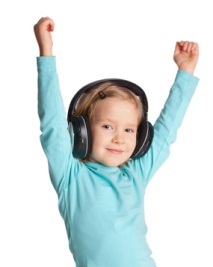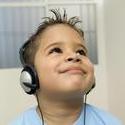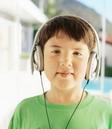Explanations On Why and How AIT Works
Commentary from Berard AIT Experts and Practitioners
Contact Us
Complete
On-line AIT Checklist
The explanations about how AIT works can be classified in different ways, such as:
-
those explaining a reduction in auditory peaks
-
a reduction in sound sensitivity
-
and an increase in attention
-
as well as postulating change in the middle ear, inner ear, and mid-brain
-
explanations
related to
biochemical changes as a result of
AIT
Two main AIT theories offer different explanations of how AIT works. They focus
primarily on changes with the listener's ability to change or shift attention by
Bill Clark and Dr. Stephen Edelsen:
1.
Tune In/Tune Out
by Bill Clark. (Bill Clark is an audio engineer and designer of the BGC
Audio Tone Enhancer/Trainer.)
Many autistic children are characterized as being deaf at times. This is
consistent with the common description of these children as `living in a shell'
and `blocking out' or `tuning out' people in their surroundings. A recent
analysis of the E-2 data from the Autism Research Institute in San Diego,
California indicated that 50% of parents suspected their autistic children of
being "very nearly deaf."
Bill Clark suggests that the modulation of the AIT music may train the listener
to `tune in' to his/her environment. Basically, the listener cannot anticipate
the random changes of the music during the listening sessions (i.e.,
modulation); and thus, he/she cannot `tune out' or ignore the music. As a
result, the person begins to listen (or `tune in') to the music. By conditioning
the person to attend to the music, the person is then able to generalize `tuning
in' to their surroundings.
2. Shifting Attention by Stephen M. Edelson.
Researchers have shown that autistic individuals often have problems shifting
their attention from one source to another. Much of this work has been performed
by Dr. Eric Courchesne and his colleagues at Children's Hospital in San Diego,
California. For example, a common situation might be: a child is playing with a
toy and is asked by a parent to get ready for dinner. Initially, the child's
attention is focused on the toy, and then he/she needs to shift his/her
attention to the parent's instruction. The average non-autistic child can shift
his/her attention within one to two seconds. However, an autistic child will
continue to perseverate on the toy, and then gradually shift his/her attention
to the parent's instruction. It may take 3 to 5 seconds, or even longer, to
shift attention. According to Dr. Courchesne, this inability to shift attention
appropriately is a result of structural abnormalities in the cerebellum.
Furthermore, Dr. Courchesne proposes that this attention shifting problem may be
a critical problem in autism. That is, if a child cannot shift attention in an
efficient manner, it will be difficult for him/her to learn about their
environment, especially to learn language. For example, if a child shifts
attention too slowly, he/she will lose the context of what was said and have
difficulty understanding.
Dr. Stephen Edelson suggests that AIT may train or condition the listener to
shift his/her attention more rapidly and more efficiently. The modulation during
the AIT listening sessions changes the music at random intervals. At one moment,
music from the low end of the frequency spectrum is presented; and at another
moment, music from the high end of the spectrum is presented. The BGC Audio Tone
Enhancer/Trainer also changes the volume level at random intervals. One might
argue that the listener is trained or taught to shift his/her attention during
the listening sessions since the AIT music is constantly changing from low to
high frequencies and from soft to loud music.
Other Explanations From AIT
Practitioners In the Field of Berard AIT
The Stapedius Muscle and
Auditory Integration Training
I believe the stapedius muscle is the mechanical link
to get sound efficiently from the middle to the inner ear, but I believe it is
the vestibular system, which is being hit hard with the
AIT input that's making
the big difference for the
AIT candidates who need work on the vestibular system (which has so many
influences on so many areas of the body and their functions) to be more fully
functioning human beings.
Dorinne Davis is an audiologist. I would think that most
occupational therapists who work
daily in the trenches, with the vestibular system, relate these functional
changes with AIT more to
vestibular influence than anything else
(meaning - not a single muscle is doing all that, as the stapedius is
simply an efficient mechanical link and another door, an quicker door, than
other doors to get to the vestibular system).
By the way, the stapedius
is a skeletal muscle, which means it is influenced, like the other skeletal
muscles (for long sustained contractions to keep us upright in space, working
against gravity, maintaining our posture and holding positions) by the
vestibular system.
Skeletal muscles are not
suppose to be under voluntary control. For our kids who have problems with
vestibular influence on these muscles, the
only way they keep themselves up against gravity is through either constant
wiggling or seeking constant external support for posture (by lying on the floor
or by leaning on surfaces).
The flexor muscle groups,
however, are influenced by the red nucleus, not the
vestibular system. Flexor muscle groups are
under voluntary control. They are phasic muscles, meant for sprinting, and are
not for sustaining. These are the muscles we use to do activities such as play
with objects, do sports, draw, write, eat, dress ourselves and engage in our
environment in so many ways. Working against gravity with the flexor muscle
groups are key to motor planning ability.
What I wrote here is not lifted
from a book. It is my belief in working with kids doing SI, NDT and
developmentally sequencing their skills for the past 30 years that this is
probably happening. Are there others in the Pro group who think differently
about this or have other information that I'm not aware of on this theory?
I believe
Auditory Integration
Training is strongly influencing the vestibular system to get the big bang!
For those kids who already have well functioning vestibular systems, maybe they
are the ones who don't seem to make the changes in function with
AIT. "
Polyvagal Theory Research
"I am aware that Steve Porges is doing research on
the Polyvagal theory which seems to have a correlation here.
Psychophysiology, 32 (1995),
301-318. Cambridge University Press. Printed in the USA. Orienting in a defensive world:
Mammalian modifications of our evolutionary heritage. A Polyvagal Theory
STEPHEN W. PORGES,
Department of Human Development, University of Maryland, College Park, USA,
Copyright, 1995 Society for Psychophysiological Research
PRESIDENTIAL ADDRESS, 1994
Abstract:
The vagus, the 10th cranial nerve,
contains pathways that contribute to the regulation of the internal viscera,
including the heart. Vagal efferent fibers do not originate in a common
brainstem structure. The Polyvagal Theory is introduced to explain the different
functions of the two primary medullary source nuclei of the vague: the nucleus
ambiguus (NA) and the dorsal motor nucleus (DMNX). Although vagal pathways from
both nuclei terminate on the sinoatrial node, it is argued that the fibers
originating in NA are uniquely responsible for respiratory sinus arrhythmia (RSA).
Divergent shifts in RSA and heart rate are explained by independent actions of
DMNX and NA. The theory emphasizes a phylogenetic perspective and speculates
that mammalian, but not reptilian, brainstem organization is characterized by a
ventral vagal complex (including NA) related to processes associated with
attention, motion, emotion, and communication. Various clinical disorders, such
as sudden infant death syndrome and asthma, may be related to the competition
between DMNX and NA.
Middle Ear Muscle and Auditory
Integration Training
My take on the "middle ear
muscle exercise" theory is that it is only a tiny part of what
Berard AIT does, and
that it may have been seized upon by non-audiologists and blown up out of
proportion. Once we started using impedance or immitance testing to obtain
tympanograms, we would see that we were not getting the ossicular fixation
pattern nor some other sign that the muscles were operating abnormally. Instead,
science found that most abnormal acoustic reflexes (the way we measure muscle
activity in impedance/tympanometry) were more often made abnormal by problems
with the VIIth, YIIIth, and/or Vth nerves - i.e. that the problem was
usually in the auditory nervous system. This leads us to the area of auditory
processing disorders. The high percentage of middle ear effusion in the history
of many of our children may be a better indicator of a more extensive immune
system problem than of the presence or absence of auditory processing problems
or the need for Berard AIT.
I think that it is probably the effects of immune system problems on the central
nervous system that helps produce (though not the only cause) both the middle
ear problems and the other symptoms.
I think that current science
has shown a much better explanation of the benefits of
AIT than muscle
exercise, namely, better neural synchrony. The better the timing of the
neural firing (think of a group of race horses all bursting out of the starting
gate at the same split second), the clearer the message at the other end (like
bringing in visual images into alignment when focusing a camera lens). There
have actually been a few P300 evoked response studies (see
AIT research) verifying this post-AIT
effect.
Stapedius Muscle and
Berard Auditory
Integration Training by Dorinne Davis
As both a Certified Tomatis
practitioner and AIT
practitioner, I will try to respond.... I have been doing research with the
acoustic reflex (AR) muscle (stapedius) pre and post
AIT since 1992. I have
consistently demonstrated that 91% of my clients changed to normal AR responses
after AIT, 8% has
changed to normal within 3 months post
AIT, and 1% continues to
have similar issues. My original N was 259 subjects. I have repeated this with
another N of 200. Now I am just collecting data for a larger N but overall my
research consistently demonstrates this change.
When I test, I do so on a
Diagnostic Acoustic Reflectometer. My original unit measured the AR down to
responses at 40 dB at 500, 1000, 2000 and 4000 Hz. This unit recently died and I
have replaced it with another Diagnostic unit which is computerized. This unit
starts at a 50 dB response again at 500, 1000, 2000, and 4000 Hz. I could set
this machine to do other frequencies as well and will in the future. The
importance of this is that most audiologist's AR units are either screening for
the present or absence of the response or begins testing at 70 dB. When starting
at 70 dB, they do not catch the over-reflexing AR's which I have found to be
very indicative for the need for
AIT, and when screening,
it doesn't tell you at what level the response is moving.
This AR response not only
impacts one's sense of hearing but also balance, coordination, and
proprioceptive responses. That is why when
AIT is done properly
that not only the audiometric hearing sensitivity levels change but changes are
also noticed with balance, coordination, and proprioception (and other areas).
This AR response will impact a number of different cranial nerves as well.
Personally, using the information that Dr. Berard
taught us, I have put together 4 indicators for identifying the ideal
AIT candidate.
But when talking about
Tomatis, one is no longer talking about
one's sense of hearing. Tomatis is all
about listening. The reason, I would assume, that the
Tomatis practitioner said that the ear
muscles have never been exercised or used properly comes about in how
Dr. Tomatis addressed the function of
the middle ear muscles. Although we can measure the AR, to date, there is no way
to specifically measure the Tensor Tympani muscle.
Dr. Tomatis talks about massaging the
two middle ear muscles. Dr. Tomatis'
method is very different from
AIT,
but they can support each other. I have consistently good positive changes with
clients who start with
AIT,
while addressing their sense of hearing, and move into
Tomatis to stabilize the effects of AIT.
Not every one needs both, the key I have found is in a test battery that I have
developed to determine when and if a sound therapy can be beneficial at all.
I am trained and certified in 13
different sound-based therapies. Each one can be beneficial but only when
introduced at the appropriate time. As for the
Tomatis
practitioner's words, well, I may have said it a little bit differently because
there is more happening because of vibrational sound stimulation and the
benefits are certainly more than the receptive language and cognitive responses.
I hope this helps a little bit. The key to understanding the benefits of all the
sound-based therapies is not hearing, listening, auditory processing, vestibular
responses or other responses, but is to evaluate the body's responses to sound
stimulation, which may be with hearing, listening, etc. It is much broader and
comprehensive and will be where all research must be focused for the future."
"My feeling is that many of our
children have problems in the way the auditory pathway it has been organized
during the infancy. That is the reason that even we give them a new auditory
tool to understand the world, they process the information in the old fashion so
the brain circuitry re-organize again in that way, keeping on mind that the
auditory stimulation environment is normally the same. It is very interesting to
know that other practitioner are also repeating the sessions."
"I don't necessarily think the
differences in the auditory system of the children we see occurred during
infancy, but more likely in utero when systems were forming. Research has found
that autistic spectrum kids brains are different with auditory structures, which
are too small or malformed. Also, the neocortex has cells that shouldn't be
there and the cerebellums have too few purkinje cells. Maybe the repeats of
AIT are necessary for
this reason, but also any changes in the environment, chelation,
supplementation, diet etc. may be causing set-backs."
Age and Auditory Integration
Training
"I would support with confidence the giving of
AIT to children as young as possible, even under the age of 12 months if the
disorder has become evident to early.
However, I believe we are
severely and unnecessarily limiting
AIT if we class it as an
auditory treatment... it is my conviction that
AIT is a
integration-training system, using the auditory-vestibular pathway, but
impacting on sensory integration systems as a toning experience, leading to
improvements in integration-based behaviors, such as attention, alertness,
responsiveness (visual responsiveness too), memory, etc...all the improvements
we see in AIT.
Still non-medical, as
non-medical as going to the gym, - but impacting on these systems all the same."
The Vestibular System and AIT
"It is important to recognize
the value of AIT as an
integration training system. We do access this system through the ears with
sound stimulation because the vestibular system is in the auditory system, or
inner ear. But due to the connections to other areas of the brain, we actually
stimulate many important functions. The data that I have posted on my website
illustrates this with pre/post test scores in a variety of areas, including
visual, motor and sensory integration. While the auditory hypersensitivity and
auditory processing problems are important indicators for
AIT, there are others
that we should not overlook. I believe that the improvements we so often see in
attention and concentration are due to the decrease in sensory problems. A
adult or child can not attend to other things if there are sensory integration
issues that are distracting him. Once
AIT brings this system
into balance, attention is available for other things. Based upon this concept,
I agree that AIT may
facilitate the neurofeedback training as the child will have better attention,
concentration, processing, etc. for the program.
The Link Between Activation of
Primitive Reflexes of the Brain Stem Through Auditory Integration Training
"I am a clinical
psychologist running a general practice and also work with children and adults
with learning problems, using
AIT
and other sensory training techniques, like vision training. Using AIT,
I mainly see children with Auditory Processing Disorder referred by an
educational psychologist. Assessments include a Scan C for auditory processing
disorder, hearing tests and a WISC, the Wechsler Intelligence Scale for
Children, plus a questionnaire identifying the most salient features of APD.
Results using
AIT
are consistently positive, with parents reporting improvements in behavior,
emotional control, listening ability, musical ability, motivation, and
concentration. Adults report the same benefits with an emphasis on clarity of
thought, organization, emotional stability and improved mood plus ability to
think on an abstract level.
My opinion is that
AIT Practitioners need to be aware of
the link between activation of primitive reflexes of the brain stem through AIT,
with other neural structures like the reflexes of the limbic system which
activates emotional defenses, like anger, fear and grief. Therapeutic responses
to these states need to be available to the client. More than a reassuring
comment is needed. I have discussed the complexity of the effects of AIT
and other sensory training methods on the personality in a manual, called the
'Neuro-psychotherapy Advanced Guide', which I usually give to my clients to read
prior to treatment. I have developed Neuro-psychotherapy, which includes AIT,
as a treatment of stress, depression, anxiety and recovery from trauma. This is
a very effective therapy for children and adults. Training in
Neuro-psychotherapy is available to psychologists."
On Regression After Berard AIT
"The regression that you may hear about in relation to
AIT is important to
understand so that you will help your child adjust more easily to the changes in
his system and his perception of his world. First, it is not just the
hearing/auditory processing that may change. Improvements may occur in all
sensory areas (i.e. vision, touch, smell, hearing, taste, proprioception, etc.)
This occurs because the vestibular system is stimulated through AIT and
typically begins to function more efficiently. Since the vestibular system is
the primary control center for sensory processing, any type of sensory
processing may be impacted.
Thus, the child experiences a
whole new world. He has to explore this new world and learn about it just as
infants and toddlers explore their world and learn. Your voice may sound
different to him, his own voice may sound different, his food may taste and
smell different, and things may look different. He may now see with depth
perception, better color, and/or better acuity, etc. It is a lot to adjust to!
The regression is usually behavioral, due to the child’s feelings of insecurity
with his new perceptions and the fact that is can take some time to integrate
all the input from the AIT.
They may want to go back to a safer time since all this new stuff is so
different!"
AIT Impacts The Cerebellum
"In addition,
AIT also impacts on the
cerebellum since there is a connection between the vestibular system and the
cerebellum. So functions that are regulated by the cerebellum may also improve.
We often see improvements in motor sequencing and planning, motor coordination,
balance, sense of direction and orientation in space, rhythm and a decrease in
anxiety, etc. As all these functions become more efficient and the system is not
overwhelmed with distorted perceptions, the child can function better and begins
to want to engage socially. However, he has had limited opportunities to learn
how to be socially appropriate. Now it is very important to provide teaching in
this area (as well as a lot of other areas!).
The teaching may (and should)
occur at school and at home. It is important to discuss social skill training
with the staff and see what arrangements can be made for this. There are also
social skills groups run at centers with speech/language therapists/social
workers and other therapists. Parents sometimes access these centers after
school on a private basis. Other options include setting up play dates with
other families in the communities, accessing the local park, etc. The key
element is to actually teach the skills, not just expose the child to other
children. I could go on and on, but really have to get to some other work! I
hope this is helpful."
Biochemical Explanations Of How and Why AIT Works
Opioid Hypothesis of
AIT by Jaak Panksepp.
There is growing evidence that some individuals with autism have elevated levels
of brain opioid activity, and some assays have suggested the presence of an
uncharacterized variant of beta- endorphin. This is supported by analysis of
opioid-like activity in their cerebral spinal fluid and the positive
responsiveness to drugs that block the action of opioids in the brain. Brain
opioids, such as beta-endorphins, are endogenous opiate-like substances in the
brain; and elevated levels of these substances are associated with either
pleasurable or anesthetic effects.
The beta-endorphin hypothesis of AIT suggests that the modulated music
stimulates, and possibly normalizes, certain areas of the brain which release
endogenous opioids. It is established that listening to music activates
endogenous opioids. One possible area in the brain involved in the release of
beta-endorphins is the inferior colliculus of the midbrain which receives sound
input and is rich in opioid receptors.
At the present time, there is no empirical support for this hypothesis. However,
it is interesting to note that naltrexone, which blocks the action of
beta-endorphins, is not recommended for schizophrenic individuals because it may
intensify abnormal social behaviors even though it can reduce auditory
hallucinations in some. Similarly, Dr. Guy Berard has always stated that AIT
should not be given to schizophrenic individuals because AIT may make their
condition worse.
Since brain-opioid activity is hard to measure, this hypothesis is presently
hard to test. However, Dr. Panksepp is currently exposing newborn chickens to
AIT music and is examining possible biochemical changes in their brain.
Preliminary results suggest that 10 days of exposure to both normal and
modulated music can have significant effects on certain brain neurochemical
systems, especially brain serotonin activity. These results were presented at
the 25th Annual Society for Neuroscience Convention in San Diego on November 13,
1995 (see the current issue of the Autism Research Review International, 1995,
Vol. 9 (4) for a summary description).
Melanin hypothesis of
AIT by Lisa Boswell
Recent studies indicate that autistic individuals do not have normal
circadian rhythms of the pineal hormone melatonin. Melatonin helps regulate a
host of neuroendocrine functions including sleep patterns and autoimmunity-both
of which are abnormal in autism. Researchers have been able to worsen autoimmune
symptoms in lab animals by altering melatonin rhythms. This hypothesis suggests
that auditory integration training (AIT) improves autism by helping to normalize
pineal function and melatonin rhythms which would improve autoimmune symptoms.
This would explain why Dr. Guy Berard noted an improvement in allergic disorders
such as eczema, hay fever, and asthma after AIT, and would support work by Drs.
Reed Warren, V.K. Singh, and others who believe that autism may be related to
autoimmune system dysfunction.
Boswell further speculates that AIT reduces sound sensitivity and improves
pineal function by increasing melanin in the stria vascularis in the middle ear.
The stria is the "battery" of the cochlea. Additional melanin in the stria would
result in changes in the endolymph and hair cell function. Melanin has many
functions, from aiding neural development to increasing neural transmission.
Melanin in the inner ear can absorb acoustic energy much as melanin in the skin
absorbs photic energy. Research has demonstrated increased strial melanin in
response to impulse noise. Increased melanin through AIT might help normalize
audiograms and mitigate the effects of hyperacusis on the pineal gland, which
responds to environmental stimuli. AIT could then improve pineal function,
normalize circadian rhythms, and decrease autoimmune symptoms.
| 





